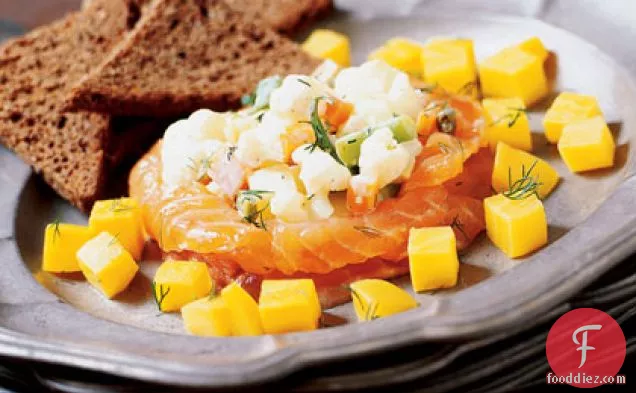Homemade Gravlax

Homemade Gravlax might be just the Scandinavian recipe you are searching for. This recipe serves 12. One serving contains 95 calories, 12g of protein, and 4g of fat. This recipe covers 9% of your daily requirements of vitamins and minerals. 1 person found this recipe to be flavorful and satisfying. If you have coarse-ground peppercorns, salt, salmon fillet, and a few other ingredients on hand, you can make it. It is a good option if you're following a gluten free, dairy free, fodmap friendly, and pescatarian diet. From preparation to the plate, this recipe takes roughly 45 minutes.
Instructions
1
In a small bowl, mix sugar, salt, and peppercorns.
Ingredients you will need![Peppercorns]() Peppercorns
Peppercorns![Sugar]() Sugar
Sugar![Salt]() Salt
Salt
Equipment you will use![Bowl]() Bowl
Bowl
2
Rub your fingers over flesh side of salmon to locate any bones; pull them out and discard. Rinse salmon and pat dry.
Ingredients you will need![Salmon]() Salmon
Salmon![Dry Seasoning Rub]() Dry Seasoning Rub
Dry Seasoning Rub
4
Sprinkle evenly with sugar-salt mixture and top evenly with dill. Cover pan airtight with plastic wrap.
Ingredients you will need![Sugar]() Sugar
Sugar![Dill]() Dill
Dill![Salt]() Salt
Salt![Wrap]() Wrap
Wrap
Equipment you will use![Plastic Wrap]() Plastic Wrap
Plastic Wrap![Frying Pan]() Frying Pan
Frying Pan
5
Nest another pie pan of the same size on fish and set 2- to 3-pound weights (such as unopened cans of food) in it. Chill 2 days; every 12 hours, uncover, baste salmon with juices, rewrap, and replace weights.
Ingredients you will need![Salmon]() Salmon
Salmon![Fish]() Fish
Fish
Equipment you will use![Pie Form]() Pie Form
Pie Form
Ingredients
Recommended wine: Chardonnay, Pinot Noir, Sauvignon Blanc
Chardonnay, Pinot Noir, and Sauvignon Blanc are great choices for Salmon. To decide on white or red, you should consider your seasoning and sauces. Chardonnay is a great friend to buttery, creamy dishes, while sauvignon blanc can complement herb or citrus-centric dishes. A light-bodied, low-tannin red such as the pinot noir goes great with broiled or grilled salmon. The Tyler Winery Santa Barbara County Chardonnay with a 4.1 out of 5 star rating seems like a good match. It costs about 30 dollars per bottle.

Tyler Winery Santa Barbara County Chardonnay
2015 brought the earliest vintage of the decade so far. After the large 2013 and 2014 vintages and the continued drought, the vines put forth a fraction of the fruit than the previous two years. They were down approximately 30% overall but the result was exceptional quality and deep, powerful wines with great acidity. Citrus, anise, saline, and energetic.DifficultyHard
Ready In45 m.
Servings12
Health Score7
Dish TypesSide Dish
Related recipes
Cherry-Apple Lattice Pie
Garlicky Green Beans
Turkey with Country Ham Stuffing
Striped Tuile Rolls
Magazine

Your Inner Chef with Taylor Swift's Top 3 Recipes from Her Beloved NYC Hangout

20 Mouthwatering Recipes You Need to Try Today!

Master the Art of Making Perfect Pancakes with This Foolproof Recipe

The Science Behind Red Wine: Its Surprising Health Benefits and Potential Risks

12 Wine Cocktails for a Sophisticated Twist

Sip, Swirl, and Celebrate: Toasting to National Wine Day on May 25th

National Drink Wine Day on February 18

Celebrating Souffle Day with Delectable Delights

Indulge in the Delightful Flavor of Oyster Soup on Its Special Day!

Celebrating World Nutella Day

A Look at the Relationship Between Nutrition and Sleep

Everything You Need to Know About Traditional German Foods

How to Cook Sushi Rice

How to Make Ice Cream in A bag

How to Make Sushi

How to Make Vegan Pasta

19 Avocado Recipes So You Never Waste One Again

21 Cabbage Recipes to Eat Every Night of the Week

14 Fantastic Cucumber Recipes for Your late Summer

16 Healthy Kale Recipes

Your Inner Chef with Taylor Swift's Top 3 Recipes from Her Beloved NYC Hangout

The Science Behind Red Wine: Its Surprising Health Benefits and Potential Risks

12 Wine Cocktails for a Sophisticated Twist

Celebrating Souffle Day with Delectable Delights

Indulge in the Delightful Flavor of Oyster Soup on Its Special Day!

These Super Recipes for Your Football Party!

The Secrets Behind 3 Classic Comfort Food Recipes

10 Warming Recipes to Beat the Cold Days

A Collection of 15 Noodle Soup Recipes to Warm Your Soul









